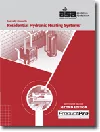John Siegenthaler: Radiant panel systems

Figure 1. The infrared thermograph of a normal (thermally comfortable) hand shows fingertip temperatures in the low to mid 80s. Graphic courtesy of John Siegenthaler
Radiant panel heating has matured from the darling of the hydronics industry in the 1990s into a respected technology that can provide excellent comfort in a wide range of applications.
Many of you have designed and/or installed at least one radiant panel system. In most cases, those systems covered most of the available floor area in each room with some type of radiant panel construction detail: Slab-on-grade, thin-slab, tube-and-plate, etc. This has become standard practice in the industry. It works well when radiant floor heating is installed in buildings with average heating loads.
However, building heating loads continue to decrease as energy codes tighten, better insulation and air sealing methods are developed, and long-term energy prices trend upward.
When the design heating load per unit of floor area decreases, so does the average floor surface temperature required of the radiant panel. In very well-insulated houses, the average surface temperature of a heated floor may only be a few degrees above the room air temperature. That’s because the floor doesn’t need to get any warmer to satisfy the heating load as determined by the room’s thermostat.
Consider a room with a design heating load of 3,000 Btu/h, and a corresponding air temperature of 70° F. The room measures 20 feet by 15 feet. If the entire floor area was covered with radiant panel, the upward heat flux requirement at design load would be:

The average floor surface temperature can be estimated using the following formula:

Where:
Ts = average floor surface temperature (°F)
q = upward heat flux (Btu/hr/ft2)
Tair = room air temperature (°F)
Thus, for the stated example:
 This temperature is a few degrees lower than normal skin temperature for hands and feet. The infrared thermograph of a normal (thermally comfortable) hand in Figure 1 shows fingertip temperatures in the low to mid 80s.
This temperature is a few degrees lower than normal skin temperature for hands and feet. The infrared thermograph of a normal (thermally comfortable) hand in Figure 1 shows fingertip temperatures in the low to mid 80s.
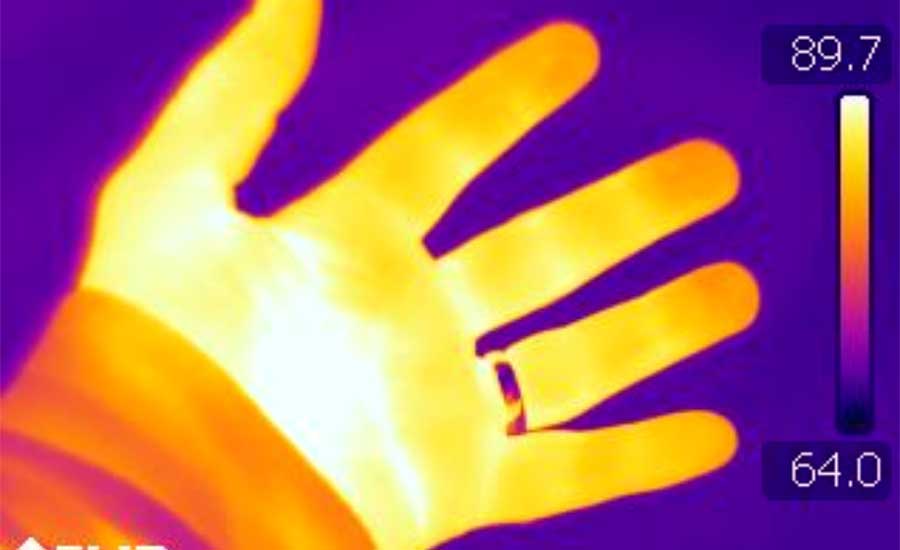
Figure 1. The infrared thermograph of a normal (thermally comfortable) hand shows fingertip temperatures in the low to mid 80s. Graphic courtesy of John Siegenthaler
A floor surface at 75° would feel slightly cool to the touch of this hand, even though that floor is releasing sufficient heat to maintain the room at 70°.
Forcing the floor to operate at higher temperatures would quickly overheat the space and likely lead to energy waste due to occupants opening windows or otherwise replacing overheated interior air with cooler outside air.
It’s also important to understand that the 75° average floor surface temperature would only exist on a design day, when outside temperatures are at or close to their lowest values. The average floor surface temperature will be even lower under partial loading conditions, which represent the majority of the heating season.
Look on the bright side
Even though a heated floor in a low-energy-use building may not be as warm as a heated floor in a more energy-wasteful building, it will still be warmer than unheated floors in rooms heated by forced-air systems or fin-tube baseboard.
Furthermore, from the standpoint of thermal efficiency of the heat source, lower surface temperatures are a good thing. Heat sources such as condensing boilers, hydronic heat pumps and solar thermal subsystems will all operate at high efficiency in combination with low water temperatures. The lower the water temperature, the higher the efficiency of the heat source.
A floor with a surface temperature just a bit warmer than the room air is also less susceptible to overheating due to unpredictable internal heat gains such as those caused by sunlight, or gatherings of people.
The potential fly in the ointment is that the owner’s expectation of warm-to-the-touch floors will likely not be realized. And, as most of you can attest, unfulfilled customer expectations are a problem, even when the heating system is working at peak efficiency.
If the customer was informed that the floors would not feel warm even though the interior set point temperature would still be maintained, and if they understood and agreed to this operating condition, there should not be any unfulfilled expectations. However, if the customer can’t get their thinking past all those cozy barefoot advertisements for radiant floor heating and still expects warm floors regardless of load, the result is likely to be serious disappointment.
The retort, “But I paid for warm floors,” will surely be heard, and your prospects for a good customer relationship are headed south. The fact that the mod/con boiler you just installed is operating at 97% rather than 92% thermal efficiency is probably not going to smooth things over.
I highly recommend having a conversation with any clients who are considering the use of floor heating in a low-energy-use building. Be sure you explain why the floors often don’t feel warm to the touch, and be sure you listen carefully to any concerns they may have regarding this. If the client’s primal instincts for warm surfaces are very evident, consider offering them some of the following alternatives.
When less is more
There are several alternatives to full-coverage floor-heating systems that provide a reasonable balance between heat source efficiency and the owner’s desire for warm surfaces. One is to make the surface area of the radiant panel smaller by not covering the entire floor area with tubing.
For example: If the size of the radiant panel in the previous example were cut in half, the necessary upward heat flux would increase from 10 to 20 Btu/hr/ft2. This would bring the average floor surface temperature under design load conditions from 75° up to 80°. This warmer floor surface temperature is more likely to appease those looking for barefoot-friendly floors. Reducing the panel area to one-third of the room’s floor area would boost the average floor surface temperature under design load conditions to about 85°, a recommended maximum for floors in a situation where there is prolonged foot contact.
The design approach of not covering the entire floor area with tubing was common in the days when copper tubing was used for radiant floor-heating installations. Each radiant panel was sized to the room load, assuming a specific upward heat flux, and specified supply water temperature. A room with half the heating load of another room would get half as many square feet of panel area. Assuming floor coverings of comparable R-value, this approach allows the system to work with a single supply water temperature and, as such, eliminates the need for multiple mixing devices.
I used this approach when designing the floor-heating system in my own house in 1979. Figure 2a and 2b show images of the floor-heating panel in our dining area. The panel was constructed using 3/8-inch copper tubing because PEX tubing was not available in North America at the time. We installed the radiant panel under the eventual location of the dining table, right where feet rest on the floor. It feels great on a cold winter morning.
Another option that integrates well with low-energy-use buildings is radiant ceiling heating. Most heated ceilings deliver 95% or more of their heat output as thermal radiation. They “shine” thermal radiation down into the room much like how a light fixture shines visible light downward.
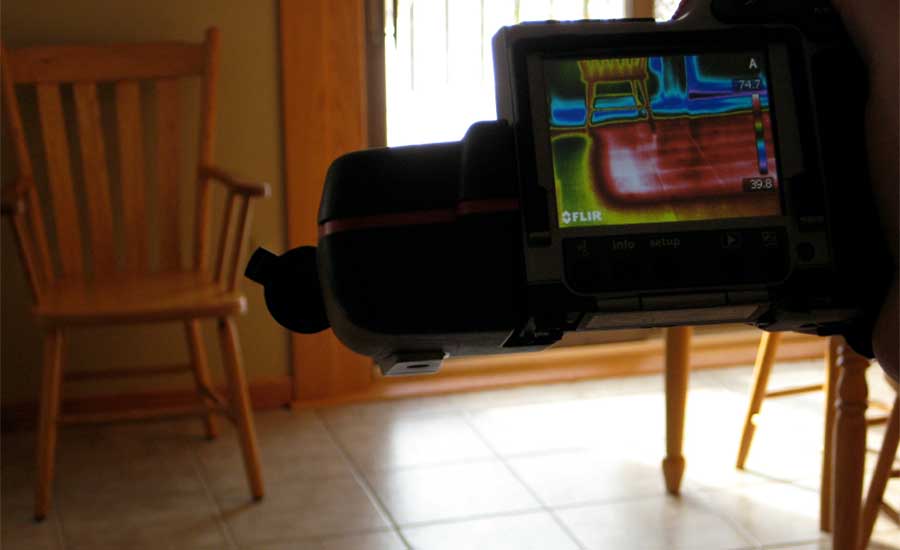
Figure 2a shows an image of the floor-heating panel in our dining area. Graphic courtesy of John Siegenthaler
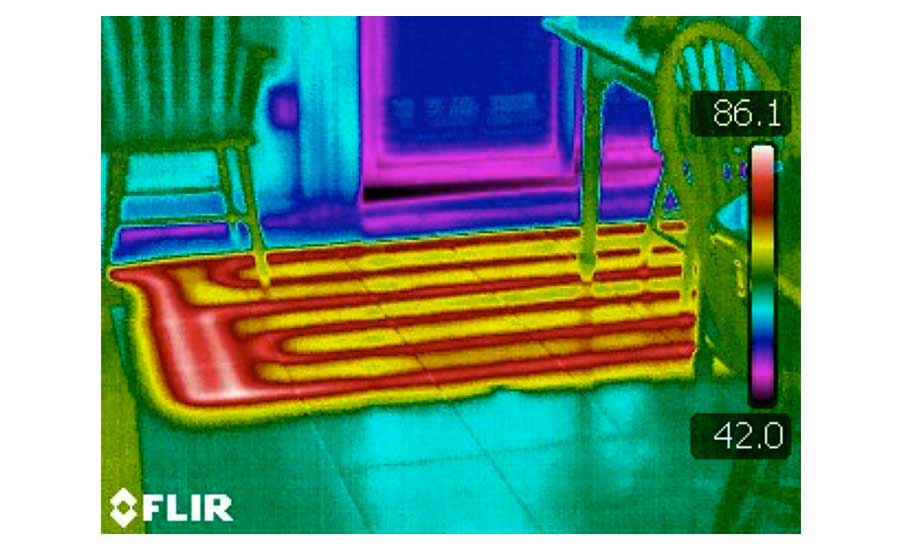
Figure 2b shows an image of the floor-heating panel in our dining area. Graphic courtesy of John Siegenthaler
Low-mass radiant ceilings, such as the construction shown in Figure 3, can quickly warm up following a cold start. They are ideal in rooms where quick recovery from setback conditions is desirable. Low mass also means they can quickly suspend heat output when necessary. This helps limit overheating when significant internal heat gains occur.
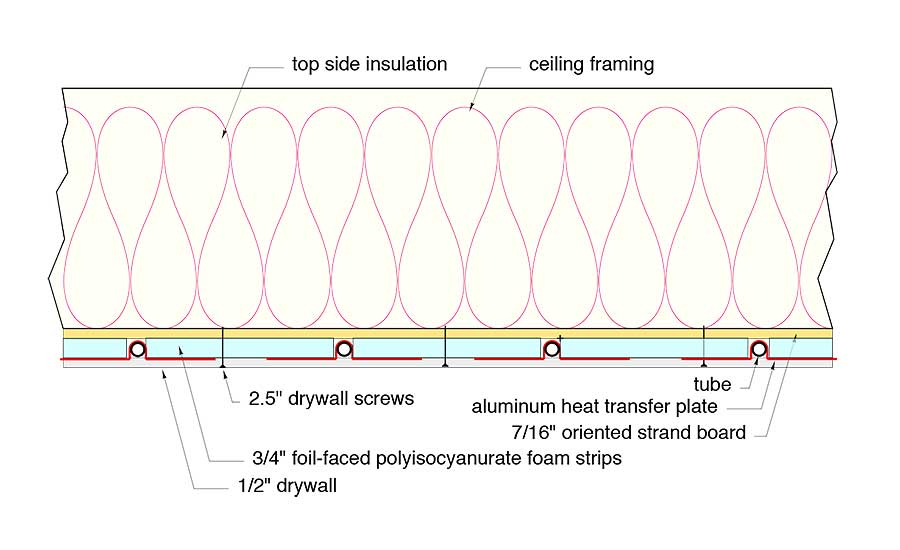
Low-mass radiant ceilings, such as the construction shown in Figure 3, can quickly warm up following a cold start. Graphic courtesy of John Siegenthaler
For a ceiling panel constructed as shown in Figure 3, an average water temperature of 110° can deliver a downward heat output of about 28 Btu/h/ft2. Consider this panel installed in the low-energy-use building with a design heating load of only 10 Btu/hr/ft2. The panel would only have to cover about 36% of the ceiling area to deliver the required heat output. This significantly reduces materials and installation labor costs. It also allows low-temperature heat sources to achieve high thermal efficiency.
Yet another option is a system using panel radiators rather than site-built radiant panels.
Panel radiators are available in a wide range of sizes and shapes and a correspondingly wide range of heat-output ratings. The most common design approach is to size a single panel radiator to the design load of a typical room such as a bedroom, bathroom or kitchen. Larger spaces may require more than one panel radiator piped in parallel.
My suggestion is to size each panel radiator in the system to provide the design heating requirement of its assigned space while operating at a supply water temperature no higher than 120°. This keeps the operating efficiency of low-temperature heat sources high. It also increases the percentage of radiant versus convective heat output and eliminates any safety concerns about occupants touching excessively hot surfaces. A panel radiator with a surface temperature in the range of 100°-115° will inevitably have people cozying up to it in cold weather. It will be a place where damp mittens, gloves and hats get placed for a quick drying. Perhaps most importantly, it provides a solution for those times when you just want to put your chilled hands, feet or derrière against a warm surface.
Figure 4 is an infrared image of a panel radiator operating at a relatively low water temperature. Notice the temperature gradient from top to bottom and how it is relatively uniform across the face of the radiator. That’s the evidence of a well-designed product.
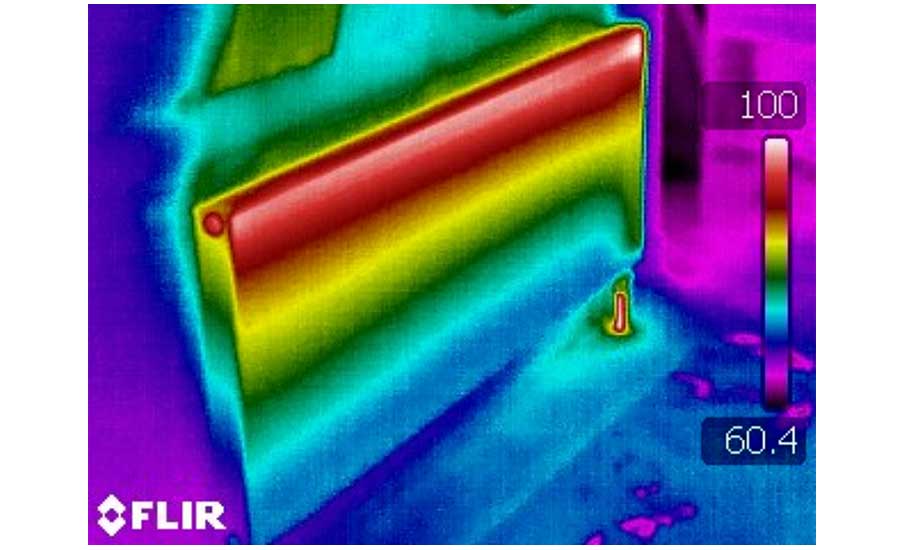
Figure 4 is an infrared image of a panel radiator operating at a relatively low water temperature. Graphic courtesy of John Siegenthaler
No worries
I’ll leave you with a final thought on lower-surface-temperature heated floors. It comes from seeing how many people I’ve accompanied over the years have reacted when first told they are standing on a heated floor.
Many will squat down, put their hand on the floor, and then stand up with a confused look on their face. They then say something like, “The floor doesn’t feel warm.” The question I follow up with is, “Are you comfortable?” Most answer “yes” or maybe even, “Yes, I’m very comfortable.” The final advice I then offer is, “If you’re comfortable, don’t worry about how the floor feels.”
Try it the next time you introduce someone to radiant floor heating.
To read Siegenthaler’s article: “Cool to the touch” in pdf form, please see here.
This article was originally titled “Cool to the touch” in the October 2018 print edition of Plumbing & Mechanical.
Looking for a reprint of this article?
From high-res PDFs to custom plaques, order your copy today!








